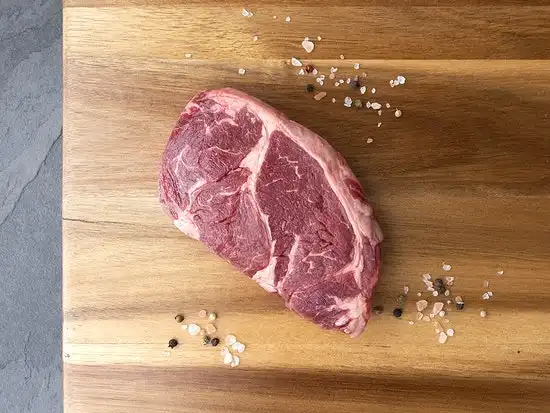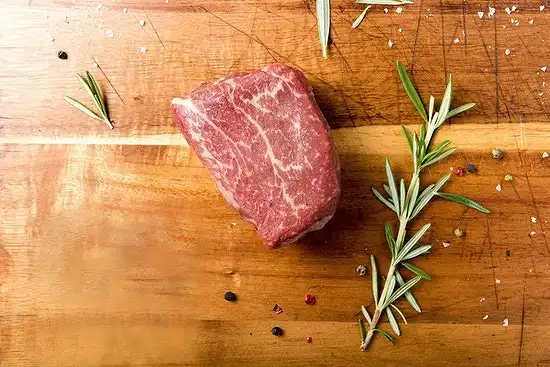Filet Mignon VS Ribeye Steak – Which is Better?

Both ribeye steak and filet mignon are famous for their tender, melt in the mouth textures.
Ribeye is well-known for its rich, meaty flavor that steak fans crave, while filet mignon is prized for its buttery smoothness.
Each cut comes from a different part of the cow, with stark contrasts in fat content and cooking methods. Every meat lover has their own, usually strong, opinion about which cut is best, but the truth is that the right choice for you depends on a variety of factors.
In this guide, we explain how to tell the difference between ribeye and filet mignon, how to determine which is best for your taste, and the correct way to cook them for mouthwatering results.
What is a filet mignon?
The name “filet mignon” comes from the French language. “Filet” means “strip” or “thread”, while “mignon” means “dainty”.
Filet mignon is a highly-regarded cut from the center of the tenderloin, which is located inside the ribcage. This muscle is known as the “psoas major” and lies alongside the ribs close to the spine. Each animal has two of these muscles, one on either side of the ribcage.
As it is not a weight-bearing muscle or one that gets exercised by the animal, filet mignon is a very tender cut that melts in the mouth. It is also one of the leanest cuts of beef, with low fat content.

Filet mignons are small, usually about 2-3 inches across and 1-2 inches thick. They are naturally round in appearance, as the psoas major muscle, from which they are cut, is tube-shaped.
When first cut from the animal, filet mignon will have a silverskin of thin, chewy connective tissue attached to it. This is often removed before sale but should definitely be removed before cooking.
Filet mignon is a great choice you’re trying to limit fat consumption. Incredibly lean and high in protein, a standard filet mignon typically contains only around 2.5 grams of saturated fat – much lower than many other varieties of steak.
FIlet mignon summary:
- Small cuts
- Very low fat content
- Soft, tender texture
- Fine grain muscle
What is a ribeye steak?
Ribeye steak comes from the longissimus dorsi muscle. This is a long muscle that runs from the shoulder blade to the hip bone from the sixth to the twelfth rib.
The longissimus dorsi doesn’t get exercised much by the cow, so it is a tender cut. However, it does contain a fair amount of “intramuscular fat” or marbling, which adds lots of flavor and moisture to the meat.

Ribeye steaks are very large cuts that average between 11-16 square inches in size. T
They can be served boneless or bone-in -with the rib bone still present in the meat. Sometimes, bone-in rib eye steaks are called “rib steaks”. The bone may protrude a few inches, or be cut so that it lays flush to the meat.
Many chefs claim bone-in cuts have greater flavor and moisture, but this has been debunked. The one advantage of bone-in is that it can insulate the meat and slow cooking.
Ribeye steak is hefty on the fat and calorie content. A 3.5-ounce steak contains around 269 calories and almost 22 grams of fat per serving – so it may not be the best choice if you’re watching your waistline.
Ribeye summary:
- Large cuts
- High fat content
- Heavy marbling
- Can be served boneless or bone-in
- Tender texture
Which is better – Ribeye steak or Filet Mignon?
Whether a ribeye steak or a filet mignon is best for you will depend on your individual taste, budget, cooking style and experience.
In this section, we take a look at the key differences and similarities between these popular cuts.
Flavour and appearance
Filet mignon is rounded and considerably smaller than ribeye steak. It has a much lower fat content that runs through the meat in thin, delicate lines. Ribeye steak is generously-sized and contains high fat levels and thick, defined marbling.
Both steaks are tender, but filet mignon is the softest. This is because the tenderloin muscle from which it is cut is barely used during the animals’ lifetime.
On the other hand, ribeye steak is cut from the ribs of the cow. These muscles are not heavily-exercised, but they are worked more than tenderloin. Therefore, ribeye steak is a little tougher, but this is compensated by its high fat content that makes it juicier and more tender than many other cuts.
The high fat content of ribeye steak gives it a stronger flavor than filet mignon. However, the lean, less-greasy taste of filet mignon is a better choice for those who are watching their weight or dislike fatty meats.
Price
Both cuts are pricey, but filet mignon is by far the most expensive. This is due to the scarcity of the meat on each animal, as well as its tenderness.
Source of the meat
Both filet mignon and ribeye are widely available and can be easily purchased at your local store, butcher or via online meat delivery services.
When shopping, we recommend looking for USDA choice and prime grade cuts. Prime grade ribeye is the most expensive option, but it will have the best fat marbling which gives delicious flavor and moisture.
Preparation
Ribeye and filet mignon require different cooking methods for best results.
Filet mignon cooks very quickly and shouldn’t be cooked above medium heat. Due to its low fat content, a high-heat or long cooking duration can dry it out, causing it to lose its tenderness.
On the other hand, ribeye steak has a high fat content that allows you to cook faster and at higher temperatures. Because ribeye is such a large cut, it’s best finished off on a medium-low grill for maximum tenderness.
When cooking ribeye, you’ll need to be careful to avoid flare ups and charring caused by dripping fat. A good pair of long grill tongs will help to keep your hands safe from any flames.
We have a recipe for coffee crusted ribeye that is worth checking out.

Wrapping it up
Both ribeye and filet mignon are delicious, highly-popular and expensive choices. There’s no clear winner here – the best steak for you depends on your preferences.
If meaty flavor is your priority, ribeye steak with its high fat content and ease of cooking makes it a top pick. On the other hand, if you prefer lean, melt-in-the-mouth steak without any greasiness – filet mignon could be your dream come true.
What do you think? Do you have a favorite? Be sure to let us know in the comments below – we’d love to hear your thoughts!










